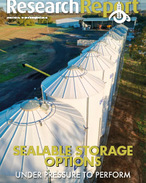This article is 5 years old. Images might not display.
Kondinin Group researcher Ben White spoke to PulseAg Consulting principal, Kerry McKenzie who said that while it may not be the ideal time to plant mungbeans, many growers are looking for a quick cash crop to generate some much-needed income.
Kerry manages the GRDC project Pulse Check and has written an article discussing the options for growers in northern NSW and southern Queensland fortunate to recieve some substantial rainfalls over the past week.
Mungbeans require a minimum of 75mm of plant available water (PAW) in the soil profile to ensure a crop will make it through to harvest, putting them on the radar of options.
Kerry points out that many paddocks are without adequate groundcover and options for generating this cover and cash flow include forage sorghum or corn crops for hay or silage.
But with a potential winter crop around the corner, nutrient removal for forage, hay or silage needs to be considered.
Kerry says with mungbean prices exceeding $1000/t within the past 12 months, the 90-day crop is on the radar for many growers but there are some concerns as to whether it is all too late.
While the planting timing will not see full potential yields, the pricing and genuine prospects of a harvest puts them in strong contention for consideration.
Because mungbean season length is driven by day-degrees, Kerry has developed a reference chart for growers.
Applying Bureau of Meteorology (BOM) forecasts, the chart is designed to help provide a best-estimate of days to maturity for mungbeans planted on the 25th of January.
Kerry also lists a range of other considerations for potential munbean growers including herbicide residuals, disease and long-fallow disorder.
For more detail, read Kerry's article here: http://www.mungbean.org.au/late-planting-options.html























